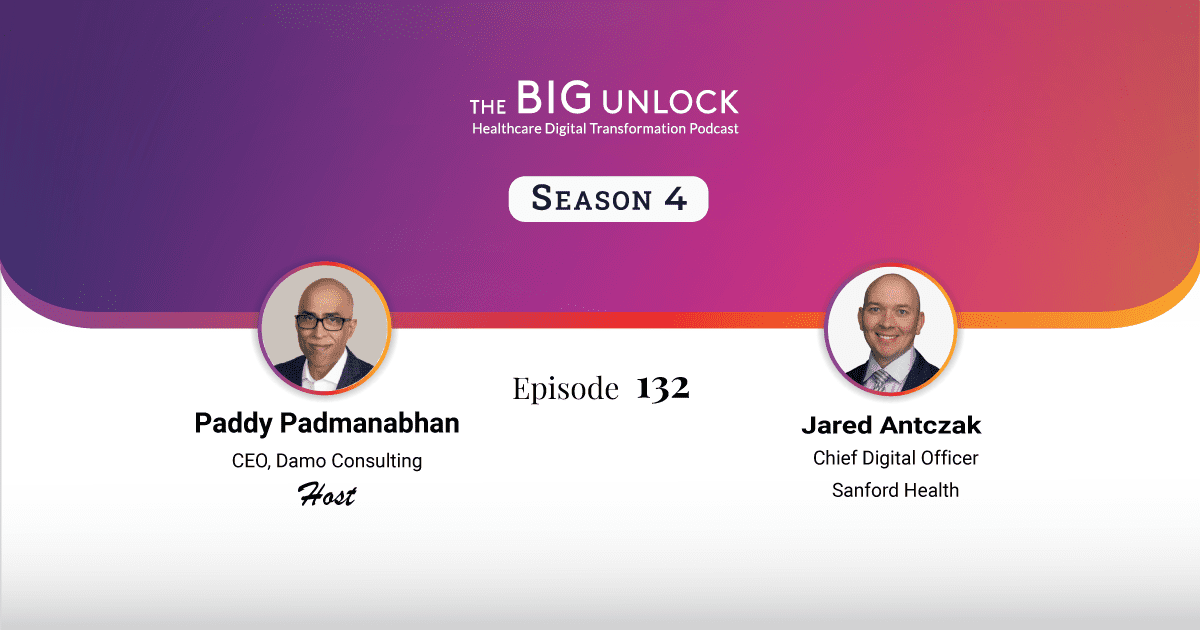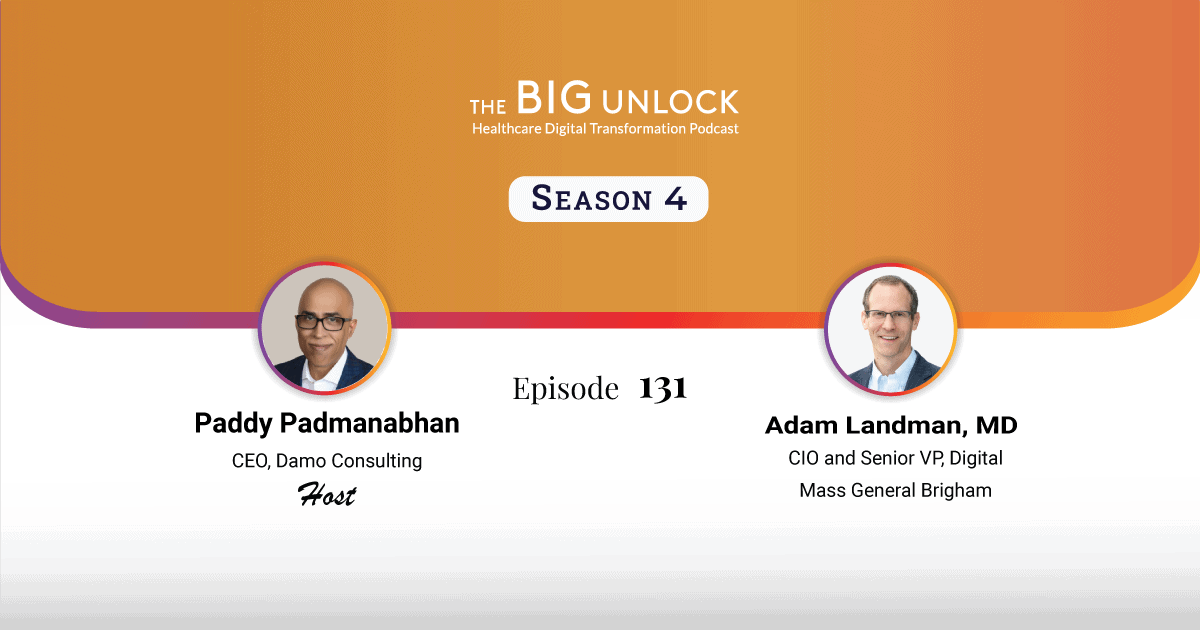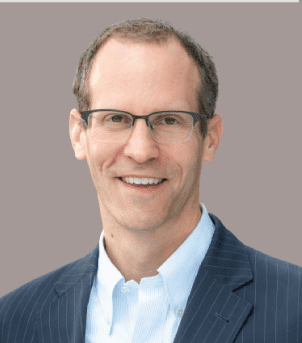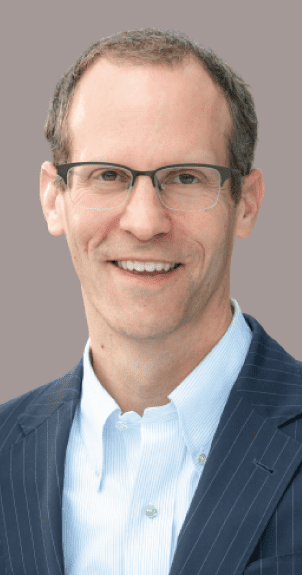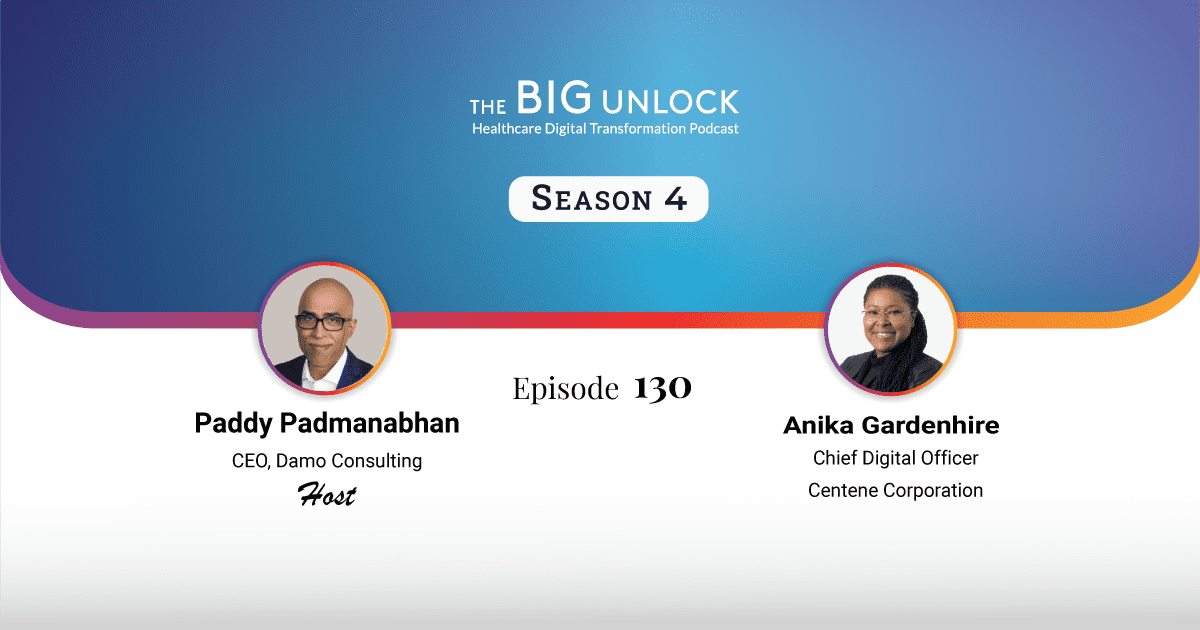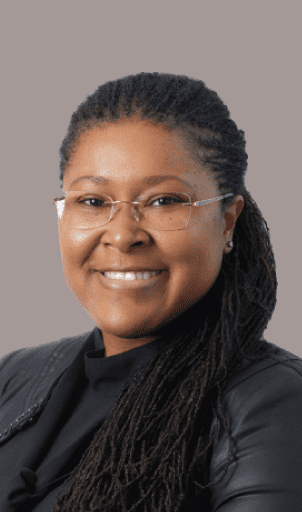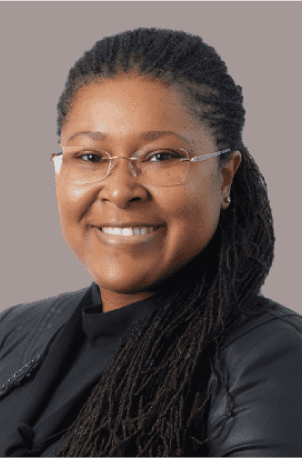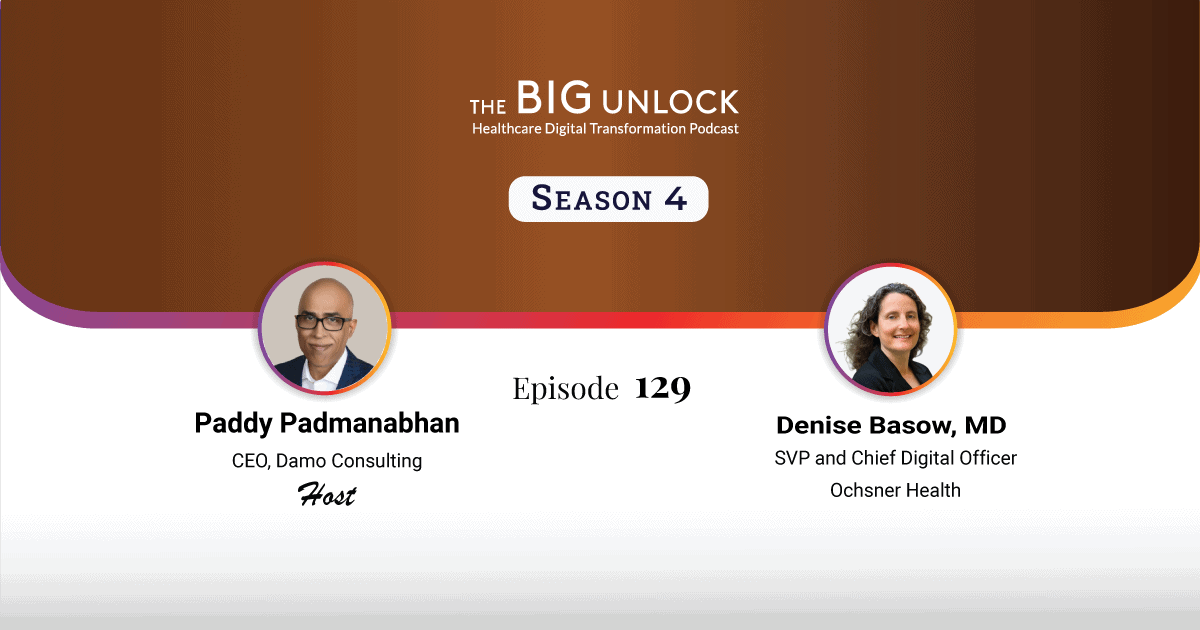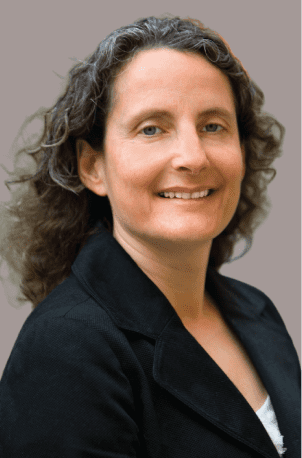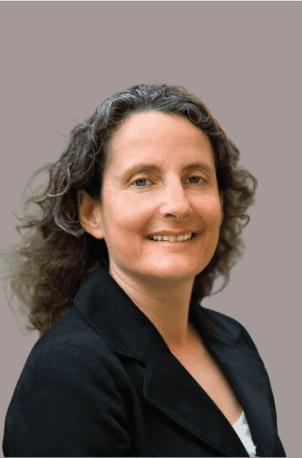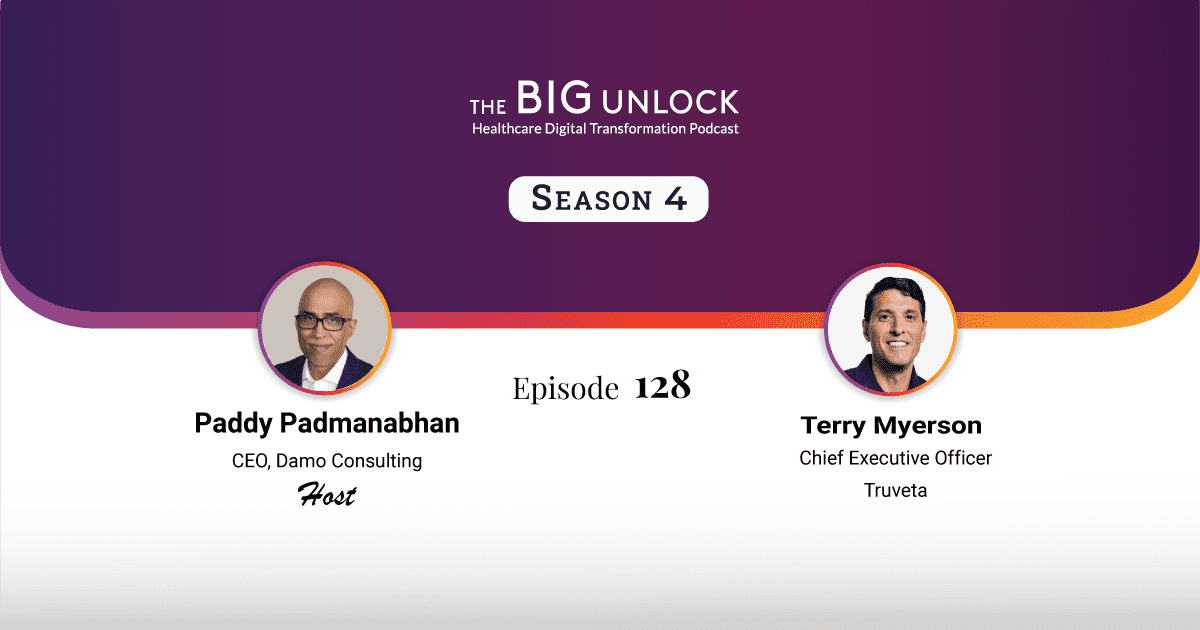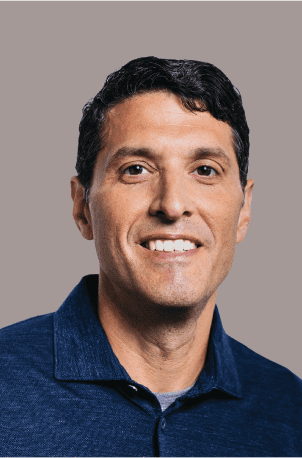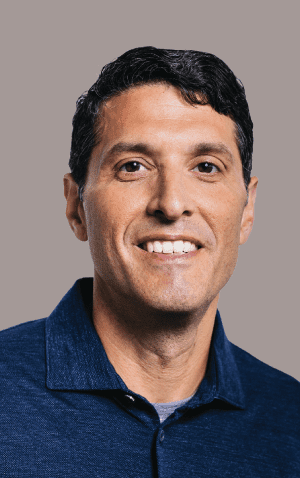Season 4: Episode #132
Podcast with Jared Antczak, Chief Digital Officer, Sanford Health
"Technology integration is one of the greatest opportunities that we have in healthcare"
 Hosted by Paddy Padmanabhan
Hosted by Paddy Padmanabhan 
Share
In this episode, Jared Antzack, Chief Digital Officer at Sanford Health, discusses the special considerations that go into serving their widely dispersed population and how they design digital solutions for that population. Sanford is a large health system that primarily serves the rural population across the upper Midwest, stretching over 250,000 square miles.
Jared’s role at Sanford ranges from being clinician-facing and consumer-facing to bridging their needs across technology, business needs, and consumer experiences. He states that digital is both about the front-end aspect of technology that users interact with as part of a broader experience and the back end that includes the infrastructure, architecture, databases, interfaces, and networks. Jared points to how the digital divide has become a social determinant of health and how they are removing the friction points to enhance digital patient experience and engagement. Take a listen.
Show Notes |
||||
| 06:01 | Can you talk to us about your priorities and how that is impacted? | |||
| 08:17 | When you talk about the types of care that are important to the populations you serve are we talking about primary care, managing chronic conditions, or acute care procedures? What is the most important gap or need now that someone in your role would be focused on? | |||
| 10:14 | Can you give us an example of a digital enablement that you've launched and implemented that addresses your needs? | |||
| 15:05 | How do you go about making your technology choices when it comes to implementing the solutions you referred to? | |||
| 19:28 | What is the need you're trying to address? What is your advice for someone who is listening to this podcast, wants to approach you, and offer you a solution? | |||
| 21:46 | Should innovators be considering some very specific attributes of your population as they develop their solution for your population? What is your advice here? | |||
About our guest
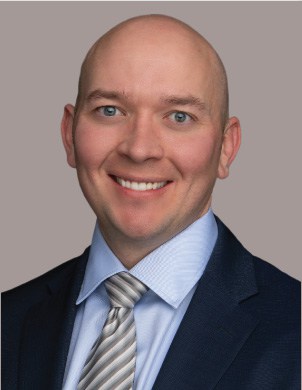
Jared Antczak serves as Sanford Health’s chief digital officer, overseeing digital strategy and transformation initiatives to enhance consumer and caregiver engagement, support care delivery, improve business processes and expand health care access through virtual care.
Antczak joined Sanford Health in 2022 after serving in leadership positions at Highmark Health, Intermountain Healthcare and Atrium Health. He holds a bachelor’s degree in biology from Brigham Young University-Idaho and an MBA from Wake Forest University, in addition to a product executive certification (PEC) and an information technology infrastructure library (ITIL) certification. He is also a certified professional in healthcare information and management systems (CPHIMS).
Originally from around Salt Lake City, Utah, Antczak lives in Sioux Falls with his wife, Charlene, and their six children.
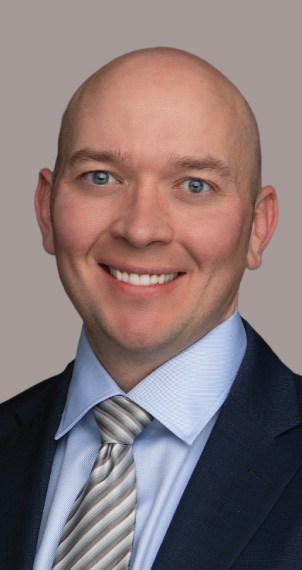
Jared Antczak serves as Sanford Health’s chief digital officer, overseeing digital strategy and transformation initiatives to enhance consumer and caregiver engagement, support care delivery, improve business processes and expand health care access through virtual care.
Antczak joined Sanford Health in 2022 after serving in leadership positions at Highmark Health, Intermountain Healthcare and Atrium Health. He holds a bachelor’s degree in biology from Brigham Young University-Idaho and an MBA from Wake Forest University, in addition to a product executive certification (PEC) and an information technology infrastructure library (ITIL) certification. He is also a certified professional in healthcare information and management systems (CPHIMS).
Originally from around Salt Lake City, Utah, Antczak lives in Sioux Falls with his wife, Charlene, and their six children.
Q: Jared, tell us a little about Sanford Health, the populations you serve, the size of the organization, and your role.
Jared: Sanford Health is headquartered in Sioux Falls, South Dakota. We cover a geographic footprint that’s approximately 250,000 square miles—across the upper Midwest— so, you can visualize a geographic footprint approximately the size of Texas.
That’s really the population that we serve in South Dakota, Minnesota, North Dakota, and a little into Iowa, as well. Two-thirds of our population are actually classified as rural population areas and so, it presents a very unique opportunity and set of challenges, especially when you’re presented with a digital strategy in terms of how do you engage that population.
I had the privilege of joining the organization earlier this year as the inaugural Chief Digital Officer. For some of the organization’s history, we’ve had this role but prior to this, I spent about a decade in the health care industry in a variety of different technology and digital strategy-oriented roles with a few different organizations. I worked on the provider side and the payer side. I’ve been in roles that have focused both on the clinician and the consumer experiences and fundamentally, always found myself in a functioning and what I would describe as a bridging role where technology, business needs, and consumer experience really converged.
Early on in my career, I worked with the health system that was implementing an electronic medical record with computerized physician order entry and electronic prescribing for the first time. I observed these providers that were spending all of their time staring at a computer screen rather than making eye contact with their patients. I supported them at 10 p.m. at night when they were trying to finish their documentation for the day because they didn’t have enough time to squeeze it in during their clinic time.
I saw firsthand then, how technology often inhibited that patient provider relationship rather than help facilitate it. That sacred moment between patient and provider was often disrupted by the technology of the day, and consequent to that realization and recognition, I actually turned down an opportunity to go to medical school so that I could focus on that problem. That’s really been the driving force behind my career ever since.
Q: What led Sanford to create this role of a Chief Digital Officer?
Jared: I think Sanford recognized that there was an untapped potential and value in digital to really drive value for the organization and the patients we serve. We’ve done a lot of really great work in the past with IT and now, I actually work closely with our Chief Information Officer, Brad Reimer, in the organization.
But really to unlock value and enable some of our goals around patient and clinician experiences, quality improvement, and cost reduction—that elusive quadruple aim that we talk about in health care–every organization is structured a little bit differently. However, the C.I.O. and I are very much joined at the head and it’s been a very incredibly productive and beneficial dynamic for the organization.
Our roles deeply complement each other, as well. We have very distinct areas of focus, but we also have fundamental areas of opportunity where we converge a lot. It really comes back to how we define digital, though.
As an organization, we’ve defined digital as the frontend aspect of technology that users or human beings interact with as part of a broader experience. That’s the focus area for myself and my team. However, there’s also a backend aspect of technology that includes the infrastructure, the architecture, the databases, the interfaces, and the networks. That’s what the C.I.O. focuses on. All these ultimately come together as part of the technology ecosystem but the focus areas are different to ensure that we’re giving the right attention and resources where it matters.
Q: Let’s talk about your populations. Those fundamental attributes drive your digital priorities in many ways. Can you talk to us about your priorities and how that is impacted?
Jared: As I think about the population that we serve across the upper Midwest, the vast majority of the counties that Sanford Health serves in this area are federally designated provider storage areas as well. So, the opportunity for digital and technology to extend reach to some of these patients who live geographically really far from a venue of care is really one of the compelling things that piqued my interest about this opportunity.
It’s not uncommon for some of our patients to travel 3 to 4 hours, sometimes just to get to the nearest doctor’s office. Unfortunately for many people, that means taking time off of work. Sometimes, for some of our farming communities, it means setting aside really valuable harvest time in order to seek the care that they need, find child care, or even transportation to make that journey.
All of those factors ultimately can become a barrier for many people to get the care that they need in order to make a difference. We know that postponing preventive care can really result in other unintended health complications or poor outcomes. We need to make it easy for our patients to be able to do the right thing and for us to do the right thing for our patients. The ability to leverage virtual care tools and digital experiences to bring care closer to home or even in the home can really become life-changing or life-saving for people who live in these communities.
Q: When you talk about the types of care that are really important to the populations you serve are we talking about primary care, managing chronic conditions, or acute care procedures? What is the most important gap or need now that someone in your role would be focused on?
Jared: To some extent, it’s all of the above. Starting with primary care, the basic preventative care needs and then, moving up the chain from episodic conditions and urgent emerging conditions to potentially elective procedures, it’s really about making sure that we’re delivering the right care in the right place at the right time and doing so in a manner that aligns with our patients and consumers’ needs in terms of when, where, and how they want to receive that care.
Some of the additional considerations we look at especially in the rural communities, is, what does digital equity look like? Digital equity in and of itself is considered a social determinant of health similar to food shortages, housing, transportation, or other determinants of health. It also looks at whether they have Internet access, reliable broadband, device availability—Do they have smartphones or tablets or computers with a camera at their disposal? Are they digitally literate? Are they comfortable downloading, registering, navigating a digital experience? Or is that potentially a barrier to entry for some of these people to be able to engage in a virtual care experience?
We’re looking across the board at all those different elements and really understanding what it is like in our community for these patients and how do we mitigate some of those barriers and points of friction so that we ultimately can deliver the right care at the right time for them.
Q: Can you give us an example of a digital enablement that you’ve launched and implemented that addresses one or more of the needs that you just described?
Jared: We’re very much in the process of evaluating some of our priorities. But as an example, we recently launched a virtual care initiative to really transform how people receive care across the upper Midwest. It was part of a $350 million initiative. Next week, we have a groundbreaking for our virtual care facility that will be our flagship building upon which this initiative will be foundational.
With that initiative, we’re looking at remote patient monitoring for example, and checking how we can ultimately get the right devices in order to be able to care for people in some of these remote communities upstream in a way that’s more proactive and where their care team can be engaged with them from a distance so they don’t have to come in to the doctor’s office in order to have their A1C checked or their blood pressure monitored.
We’re looking at different devices that potentially can connect just based off of a cellular signal without the need for broadband access. We’re looking at how to make the experience as plug-and-play as possible.
One example that we’re exploring is for patients who are in our hospitals who might be eligible for an early discharge with remote patient monitoring as an option for that post-acute care. We’re bringing the devices to the patient while they’re still in our facilities, showing them how to connect and use it. The attempt is to demystify the experience for them so that they feel comfortable and confident about being able to use it at home. Then, when we send them home with the device, we follow-up to make sure that they’re still able to use it. That mitigates the amount of time that they have to spend in our facilities and allows them to return home in the comfort of their own atmosphere and environment to heal.
Q: Can you talk to us about your payer mix? How you develop solutions that address the greatest common denominator across multiple populations with various needs?
Jared: We have a pretty balanced payer mix in terms of commercial, Medicaid, and Medicare across that spectrum. However, Sanford is very much on the journey that a lot of organizations are on in terms of the shift to more of a value-based care model.
With that shift, the value and ability for digital to potentially create value for both our patients and the organization becomes that much more important because we start to get upstream more from the traditional visit and encounter RVU model in terms of caring for patients. We think about patients a little bit more holistically and want to keep them out of the hospitals and away from expensive, costly venues of care. Ultimately, that’s where different digital technologies, potentially remote patient monitoring among other aspects really come into play creating considerable value for the organization and patients.
We’re very much on that journey where we have one foot in and one foot out in a traditional health care landscape. Like a lot of organizations, we’re trying to figure out the best way to accommodate our patients needs and meet the organization’s needs at the same time.
Q: How do you go about making your technology choices when it comes to implementing these solutions that you’re referring to?
Jared: Sanford is actually on a single instance of Epic, and that’s quite an accomplishment for an organization our size. That instance of the EMR was actually implemented in some of our locations over 12 years ago.
If you think about the population that we serve, a considerable part is fairly static. There aren’t many moving in or moving out from some of these areas. We have a really long history of clinical data and longitudinal data sets in terms of some of these patients, which is really, really valuable for us and them in order to help generate the right kinds of insights and help keep them all while managing their conditions.
But, like every organization, I think in order to determine what digital technology is the right fit for us, I always go back to making sure that we have articulated the right problem to solve. In health care, it’s easy to fall into the trap of starting with the solution, and being dazzled by the bells and whistles that you see in a demo and then, moving forward with a particular solution, and then, working backwards to try to figure out, what problem it can solve. That’s a trap I’ve seen a lot of organizations fall into.
One of the things that we’re very deliberate and intentional about is making sure that we understand what problems we’re trying to solve, how those problems align with our strategy and how they meet our patients’ underserved needs or jobs to be done. Ultimately, are they desirable for our patients? Are they viable for the business? Are they feasible from a technology and an operational standpoint? That allows us to ensure that we’re taking the right solution to solve the right problems and that we’re getting the greatest value out of it.
Q: The populations that you serve are fairly stable and don’t move a lot. You’ve gathered longitudinal data to understand this segment. How are you leveraging all of that?
Jared: We do have analytics, machine learning, and artificial intelligence function within our organization. It really is intended to take advantage of that really robust data set that we’ve been able to curate over the years and derive some machine learning in order to generate insights about our population. Ultimately, it’s intended to get the right nudges and next best actions either into the clinician workflow or directly to the patients so they can be proactive. The right actions will help people to stay well, look at different risk factors that ultimately may potentially help predict different conditions, and ensure going upstream from there so we can provide the right treatment proactively to keep people well. It’s a really exciting area and one that we’re in the process of looking to grow and expand at the same time.
Q: What is the need you’re trying to address? What is your advice for someone who is listening to this podcast, wants to approach you, and offer you a solution?
Jared: This is something that we deal with on a daily basis. One of the things that we’re really trying to do as an organization is be very intentional and deliberate about making sure that we’re aligning the right sorts of opportunities with the right challenges, or opportunities that we’re trying to solve for.
We have this concept of the 80-20 rule where 80% of the time we want to define the problem, then, go out and compare different solutions that might be in the marketplace. Then, narrow down the right vendors depending on which ones meet our needs the best and ultimately, go forward in that way. But then, 20% of the time, we want to be able to have that sort of outside-in inspiration. There may be something that a particular vendor has identified in terms of an opportunity or an underserved need that maybe just hasn’t hit our radar for whatever reason. We don’t want to close ourselves off to those opportunities either but we want to make sure that we are also bringing those in through a consistent process.
We have a dedicated team that is on point for managing some of that intake as well as the outreach in terms of our vendor evaluations and selections.
Q: Should innovators be considering some very specific attributes of your population as they develop their solution for your population? What is your advice here?
Jared: I think the challenge is that our population is still relatively diverse though we do have a lot of people in urban settings. We have the farmer that’s out on the field that may or may not have broadband access or may or may not be as digitally savvy. We also have the financial advisor sitting in downtown Sioux Falls that we’re serving as part of our population.
Recognizing not only the population but how a particular solution can meet some of their needs is key. From a technology integration standpoint, it’s really important that we’re removing friction regardless of the type of user or persona that we might be trying to serve.
Integration is one of the greatest opportunities that we have in health care. Everybody wants that sort of Amazon-like experience. When Amazon comes out with a new set of features or functionality or capabilities, they don’t create a new app for that. There’s that old saying back in the early 2000s, “There’s an app for that.” Nowadays, it’s just part of the experience.
What we want to create is the Sanford experience. We don’t want a proliferation of point solutions where we’re asking our patients to go out and download a new app for this and that. We want it to become integrated and seamless. We want that digital front door experience where it’s cohesive, intuitive, and matches the user’s mental model. We have the ability to integrate through APIs or software development kits, the right capabilities from our partners and vendors, as well as any capabilities that we build in-house into that cohesive and seamless experience to remove friction so that our patients can engage in a meaningful way.
We hope you enjoyed this podcast. Subscribe to our podcast series at www.thebigunlock.com and write to us at [email protected]
Disclaimer: This Q&A has been derived from the podcast transcript and has been edited for readability and clarity
Recent Episodes
About the host
Paddy is the co-author of Healthcare Digital Transformation – How Consumerism, Technology and Pandemic are Accelerating the Future (Taylor & Francis, Aug 2020), along with Edward W. Marx. Paddy is also the author of the best-selling book The Big Unlock – Harnessing Data and Growing Digital Health Businesses in a Value-based Care Era (Archway Publishing, 2017). He is the host of the highly subscribed The Big Unlock podcast on digital transformation in healthcare featuring C-level executives from the healthcare and technology sectors. He is widely published and has a by-lined column in CIO Magazine and other respected industry publications.

